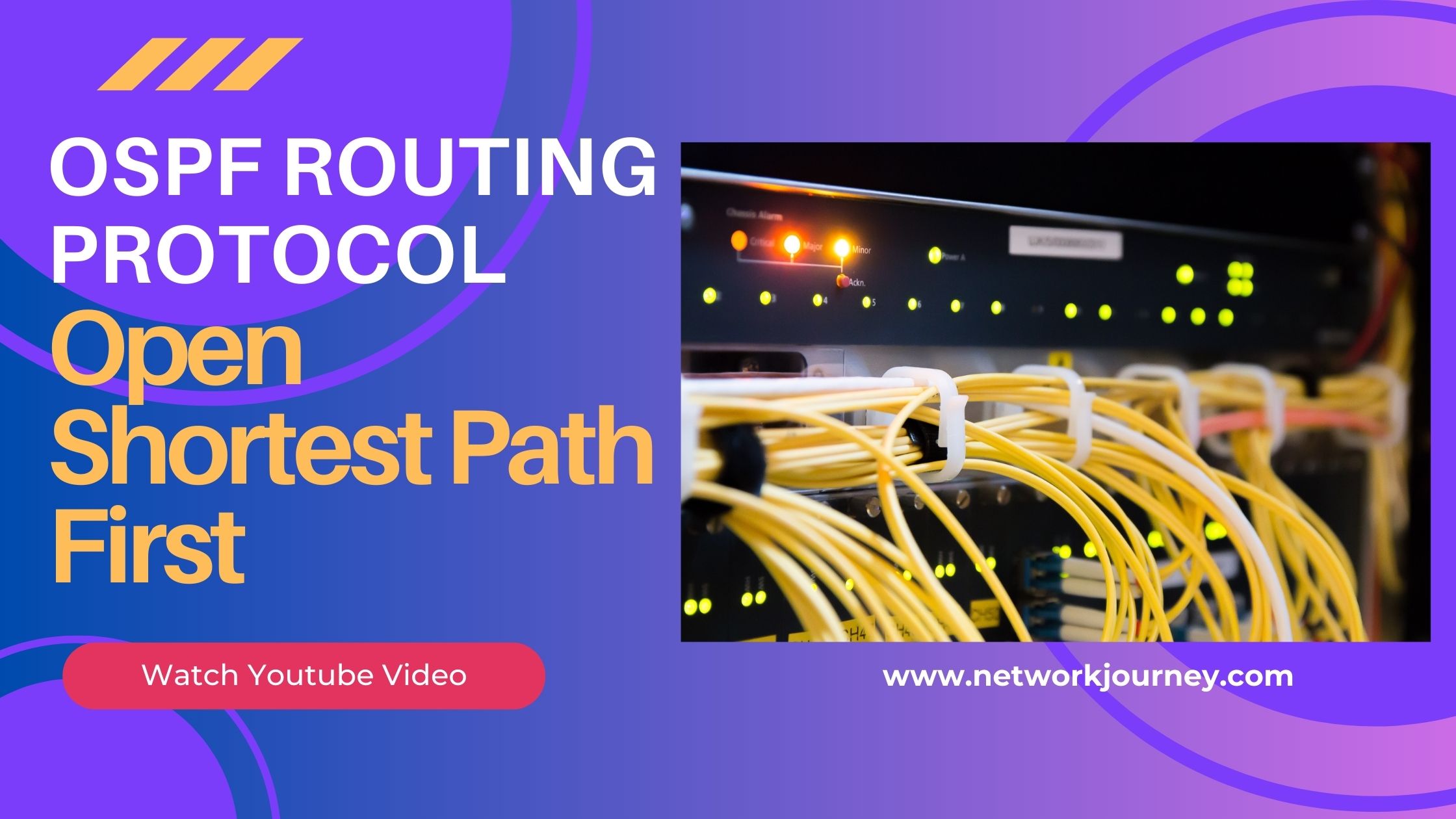Table of Contents
Introduction About OSPF Protocol
OSPF (Open Shortest Path First) is a link-state routing protocol that is used to find the best path between two routers in an IP network. It is an Interior Gateway Protocol (IGP), which means that it is used to route traffic within a single autonomous system (AS). OSPF is a very popular routing protocol, and it is used by many large networks, including the Internet.
What is OSPF protocol?
OSPF is a link-state routing protocol. This means that each router in an OSPF network maintains a database of all the links in the network. This database is called the link-state database. The link-state database is used to calculate the shortest paths between all pairs of routers in the network.
OSPF Areas
OSPF networks can be divided into areas. An area is a logical grouping of routers and links. Routers in the same area share the same link-state database. This allows OSPF to scale to large networks.
Different states of OSPF
OSPF routers can be in different states. The different states are:
- Down: The initial state when OSPF is not operational.
- Init: The router has sent a hello packet and is waiting for a reply.
- 2-way: The router has received a hello packet from a neighbor, indicating bidirectional communication.
- Exstart: The routers negotiate the initial sequence numbers for database synchronization.
- Exchange: The routers exchange database description (DBD) packets to exchange information about their link-state databases.
- Loading: The routers request and receive missing link-state information from their neighbors.
- Full: The routers have a complete view of the network and are fully adjacent.
Working of OSPF Protocol
- Router startup: When a router starts, it goes through a process called OSPF initialization, where it initializes OSPF parameters and forms adjacencies with neighboring OSPF routers.
- Hello protocol: OSPF routers use a hello protocol to discover and establish neighbor relationships. Hello packets are sent periodically to multicast addresses, and routers listen for these packets to identify neighboring routers.
- Building the topology database: OSPF routers exchange link-state advertisements (LSAs) to build and maintain a consistent view of the network topology. Each router floods LSAs to its neighbors, who, in turn, flood them to their neighbors, creating a database of LSAs that describe the network.
- Shortest Path First (SPF) algorithm: OSPF routers run the SPF algorithm to calculate the shortest path to each network destination. This algorithm uses the link-state database to determine the best paths based on metrics such as link cost.
- Updating routing tables: Based on the SPF calculation, OSPF routers update their routing tables with the best paths to reach network destinations. The routing table contains the next-hop information for forwarding packets.
How OSPF Establishes Neighbor Relationships
OSPF routers establish neighbor relationships with each other by exchanging hello packets. Hello packets are used to discover neighboring routers and to agree on the parameters of the OSPF protocol.
Benefits of OSPF Protocol
OSPF has many benefits, including:
- Scalability: OSPF can scale to large networks.
- Robustness: OSPF is a very reliable routing protocol.
- Efficient: OSPF is an efficient routing protocol.
- Secure: OSPF can be configured to use authentication.
- Load balancing: OSPF allows for equal-cost multipath (ECMP) routing, where multiple paths with the same cost can be used simultaneously, distributing traffic across multiple links.
- Fast convergence: OSPF employs a fast convergence algorithm, allowing routers to quickly adapt to network changes and recalculate the shortest paths.
OSPF v3 vs OSPF v2
OSPF v3 is the latest version of OSPF. OSPF v3 includes many new features, such as support for IPv6, authentication, and multipath routing.
| OSPF v2 | OSPF v3 |
| IPv4 | IPv6 |
| IPv4-specific packet formats | IPv6-specific packet formats |
| 32-bit router ID | 128-bit router ID |
| 32-bit area IDs | 128-bit area IDs |
| supports various authentication methods | mandates the use of IPsec for authentication |
| uses multicast hello packets for neighbor discovery | uses link-local IPv6 addresses for neighbor discovery |
| 7 LSA types | has two new LSA (LSA 8 and LSA 9) |
| 24 bytes | 16 bytes |
| uses link-state and AS scope | uses link-local, area, AS, and site scope |
10 Frequently Asked Questions & Answers About OSPF Protocol
Here are 10 frequently asked questions and answers about OSPF protocol:
10.1 What is the difference between OSPF and RIP?
OSPF and RIP are both interior gateway protocols (IGPs) that are used to route traffic within a single autonomous system (AS). However, there are some key differences between the two protocols. OSPF is a link-state routing protocol, while RIP is a distance-vector routing protocol. This means that OSPF routers maintain a database of all the links in the network, while RIP routers only maintain a table of the distances to other routers. OSPF is also more scalable than RIP, and it can handle larger networks.
10.2 What is the purpose of OSPF areas?
OSPF networks can be divided into areas. An area is a logical grouping of routers and links. Routers in the same area share the same link-state database. This allows OSPF to scale to large networks.
10.3 How does OSPF establish neighbor relationships?
OSPF routers establish neighbor relationships with each other by exchanging hello packets. Hello packets are used to discover neighboring routers and to agree on the parameters of the OSPF protocol.
10.4 What are the different states of OSPF?
OSPF routers can be in different states. The different states are:
- Down: The router is not participating in OSPF.
- Init: The router is trying to establish neighbor relationships with other routers.
- 2-way: The router has established neighbor relationships with other routers.
- ExStart: The router is exchanging link-state information with other routers.
- Full: The router has a complete copy of the link-state database.
10.5 How does OSPF calculate the shortest paths?
OSPF uses the Dijkstra algorithm to calculate the shortest paths between all pairs of routers in the network. The Dijkstra algorithm is a recursive algorithm that works by building a tree of all the routers in the network. The tree is built by starting at a router and then adding the router’s neighbors to the tree. The algorithm then continues to add the neighbors of the router’s neighbors to the tree, and so on. The shortest paths are the paths that contain the fewest number of links.
10.6 What are the benefits of OSPF?
OSPF has many benefits, including:
- Scalability: OSPF can scale to large networks.
- Robustness: OSPF is a very reliable routing protocol.
- Efficient: OSPF is an efficient routing protocol.
- Secure: OSPF can be configured to use authentication.
10.7 What are the limitations of OSPF?
OSPF has some limitations, including:
– Complexity: OSPF is a complex protocol to configure and manage.
– Overhead: OSPF routers exchange more traffic than RIP routers.
– Security: OSPF is not as secure as some other routing protocols.
10.8 What is OSPF v3?
OSPF v3 is the latest version of OSPF. OSPF v3 includes many new features, such as support for IPv6, authentication, and multipath routing.
10.9 What is the difference between OSPF v2 and OSPF v3?
OSPF v2 and OSPF v3 are the two main versions of OSPF. OSPF v2 is the older version, and it does not support IPv6 or authentication. OSPF v3 is the newer version, and it supports IPv6, authentication, and multipath routing.
10.10 How do I configure OSPF?
The configuration of OSPF varies depending on the router and operating system. However, the basic steps involved in configuring OSPF are:
- Enable OSPF on the router.
- Configure the OSPF area.
- Configure the OSPF interfaces.
- Configure the OSPF routing table.
Conclusion
OSPF is a powerful and versatile routing protocol that is used by many large networks. It is a good choice for networks that need to be scalable, reliable, and efficient.
I hope this overview of OSPF protocol was helpful. Let me know if you have any other questions.
You can learn more about OSPF Protocol in the below Video conducted by our Trainer Mr. Sagar Dhawan





